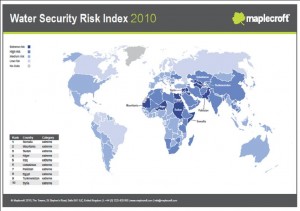Water Shortages Threaten Global Security
Jul 11th, 2010 | By Michael Bittner | Category: Climate Change, SustainabilityA new report evaluating the water security of 165 countries has been developed by Maplecroft, a firm specializing in corporate risk intelligence. The Water Security Risk Index can be used by multinational companies to identify potential risks to their operations and global supply chains. The report concludes that water shortages and competition for water have an impact on global security.
The index analyzes several key factors associated with water security:
- access to improved drinking water and sanitation
- availability of renewable water
- reliance on external water supplies
- the relationship between water supply and demand within a country
- the overall water dependency of each country’s economy
In all, 10 nations have been rated as extreme risk:
- Somalia
- Mauritania
- Sudan
- Niger
- Iraq
- Uzbekistan
- Pakistan
- Egypt
- Turkmenistan
- Syria
Security Concerns from Water Shortages
Countries in the extreme risk category, including the emerging economies of Pakistan, Egypt and Uzbekistan, are already experiencing internal and cross-border tensions due to limited water resources. Furthermore, as the global climate changes, water stress is predicted to become more acute in these regions and has the potential to threaten stability. Consider the following:
- Pakistan’s long-running dispute with India over Kashmir is partially fuelled by competition for critical water resources that are needed to maintain the growth of industry and investment for both countries.
- Egypt, which is dependent on water from the Blue Nile, is currently threatening legal action over the construction of the Gibe III dam in Ethiopia, which will further jeopardize Egypt’s limited supplies.
- In Uzbekistan, a country with good access to quality drinking water, tensions are rising with Kyrgyzstan and Tajikistan because of hydroelectric projects on the rivers that flow into the country.
“Climate change and increasing demands from population growth will cause a worsening of water stress over the coming decades,” said Dr. Anna Moss, environmental analyst at Maplecroft. “Conflict is likely to spread and intensify as a result of a lack of water security and for the countries that are heavily reliant upon external supplies the issue of water may become critical.”
About Maplecroft
Maplecroft is a leading source of global risk analysis. They research, index and map over 500 risks and issues to identify exposures and opportunities in both countries and companies. Maplecroft’s products and services are a vital resource for businesses and investors requiring analysis and insight into complex political, economic, social and environmental risks.
About the Author
Michael Bittner is an associate partner in the Boston, U.S.A. office of Environmental Resources Management (ERM) and editor of the EHS Journal. He has more than 20 years of experience in the EHS field, including 17 years of EHS consulting experience and four years as the corporate environmental manager for a U.S. Department of Defense contractor. Mr. Bittner specializes in global EHS solutions including
- Compliance and management systems auditing
- EHS management systems implementation and design
- Sustainability solutions
- Strategic planning
- Mergers and acquisitions support
Image: Water Security Risk Index 2010, courtesy of Maplecroft, Bath, United Kingdom.



[…] raw materials. They could also lead to sociopolitical instability (see the EHS Journal article “Water Shortages Threaten Global Security”), which could cause businesses to run their existing operations at suboptimal levels or delay or […]
The Atlas of International Freshwater Agreements, which was published by the United Nations Environment Programme in 2002, provided additional insight into water security risk.
• At the time of publication, there were 263 rivers that either crossed or demarcated international political boundaries.
• Europe had the largest number of international basins (69), followed by Africa (59), Asia (57), North America (40), and South America (38).
• The world’s 263 international river basins accounted for nearly one-half of the earth’s land surface, generated roughly 60% of global freshwater flow and were home to approximately 40% of the world’s population.
• A total of 145 countries contributed territory to international basins. The Danube River alone had seventeen riparian states, while the Congo, Niger, Nile, Rhine, and Zambezi rivers were each shared by more than nine countries.